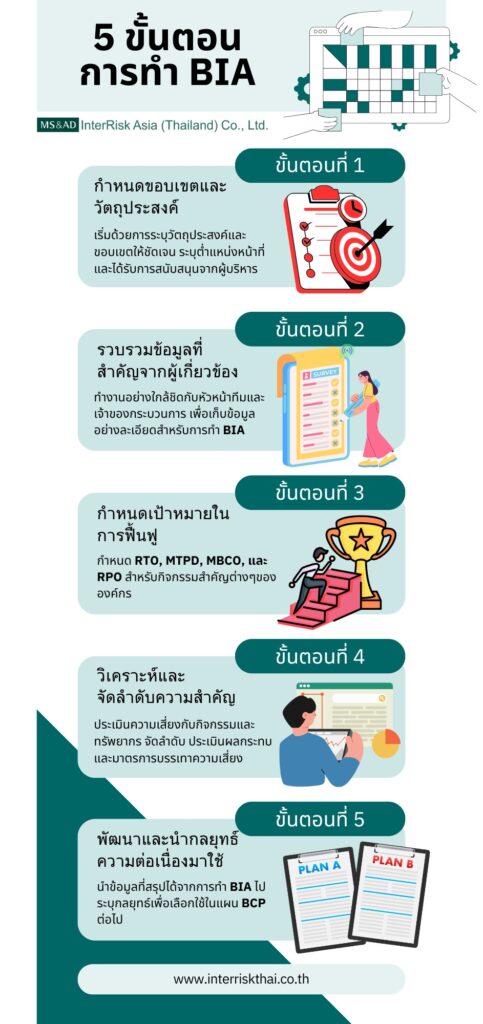Today’s businesses face numerous disruptions. From cyber attacks and supply chain failures to natural disasters and unexpected system outages. The key difference between companies that recover quickly and those that don’t lies in Business Continuity Management Systems (BCMS).
The heart of an effective BCMS lies in Business Impact Analysis (BIA), a process that many organizations tend to overlook. In this article, we’ll introduce you to BIA and guide you through the steps of conducting a business impact analysis.
BUSINESS IMPACT ANALYSIS or BIA What is it?
Business Impact Analysis (BIA) is the process of analyzing the impact over time of a disruption on an organization. According to the ISO 22301 standard, business impact analysis is a key component of Business Continuity Management (BCM).
Identify the critical business activities (Prioritized Activities) that require rapid recovery.
Assess the potential impacts of a disruption, such as financial loss and damage to reputation.
Establish clear recovery priorities, such as Recovery Time Objective (RTO), Maximum Tolerable Period of Disruption (MTPD) for the prioritized activities.
Ensure resources are allocated where they matter most in a crisis.
The outcome of conducting a BIA, as described above, is the identification of business continuity requirements. These requirements directly influence the selection of a business continuity strategy and the development of a Business Continuity Plan (BCP).
BIA vs RA What are the differences ?
Many organizations that are still unfamiliar with the principles of business continuity management may confuse Business Impact Analysis (BIA) with Risk Assessment (RA). Today, we will summarize the differences between BIA and RA in a simple table below to make it easier to understand.
Objectives
BIA
RA
Results
BIA
RA
Measurement of impact
BIA
RA
You can see that the BIA focuses on analyzing the impacts to business to determine business continuity requirements such as identifying critical activities, various types of impacts, and necessary resources, so that the organization can continue operating during disruptions. On the other hand, Risk Assessment is about identifying various risks that could affect the organization and lead to disruptions. Therefore, it is clear that effective business continuity management requires the use of both techniques to ensure a comprehensive analysis.
Objective of Conducting BIA
The objectives of conducting a Business Impact Analysis (BIA) are as follows:
- To assess the impact of disruptions on the organization.
- To identify business requirements related to regulations, contracts, and laws.
- to determine Maximum Tolerable Period of Disruption (MTPD).
- To define the Recovery Time Objectives (RTO) for the organization’s prioritized activities.
- To identify the resources required for prioritized activities during a disruption.
- To define the maximum acceptable period for data loss (Recovery Point Objective, RPO).
- To define the Minimum Business Continuity Objective (MBCO) for the organization’s key products and services.
- To identify the level of dependency between the organization, suppliers, and stakeholders.
- To identify any Interdependency among prioritized activities and processes.
- To assess and validate the scope of the Business Continuity Management System (BCMS).
Steps in conducting a Business Impact Analysis (BIA)
Conducting a BIA isn’t as difficult as you might think. In this article, we’ve broken down the BIA process from the ISO standard into five simplified steps below.

Define the Scope and Objectives
Start by asking why you are conducting a BIA and which areas of the business you want to cover such as IT systems, supply chain resilience, or customer service continuity. Define the main objectives and scope before beginning the analysis.
Tip: If your organization is large, start with a pilot BIA in one department before expanding it across the entire company.
Gather key information from stakeholders.
A successful BIA relies on accurate and detailed information, which means working closely with department heads and process owners to gather real insights. Here’s what needs to be done:
- Conduct interviews with department heads to understand the department’s key processes and activities.
- Collect information through BIA questionnaires, review, and analyze past disruptions (if data is available) to gather insights on prioritized activities and recovery time-frames.
Tips: Communicate openly. Employees involved in operations understand the risks best. Therefore, they should be involved in conducting the Business Impact Analysis (BIA).
Define recovery objectives (RTO, RPO, MTPD, MBCO).
One of the most important parts of a Business Impact Analysis (BIA) is identifying business continuity requirements in order to prioritize the urgency of activities that need to be restored during a disruption. This can be done by identifying the following four objectives for each prioritized activity:
- Recovery Time Objective (RTO)
- Recovery Point Objective (RPO)
- Maximum Tolerable Period of Disruption (MTPD)
- Minimum Business Continuity Objective (MBCO)
Tips: Work closely with department heads to realistically determine these values, as they will define your entire business continuity and disaster recovery strategy.
Analyze and prioritize risks.
The next step is risk assessment to identify risks that may cause disruptions. This process includes three detailed steps:
- Assessing the likelihood and impact of risks using a Risk Matrix.
- Identify Single Points of Failure, which are bottlenecks that could cause the entire system to shut down when a disruption occurs.
- Evaluate current mitigation measures — Consider which plans are already in place and whether they are sufficient.
Tips: This step helps assess whether the investment in business continuity measures is appropriate, such as backup systems, alternative suppliers, and automated recovery tools.
Develop and implement business continuity strategies.
Once all the information is in hand, the organization can use the results and business continuity requirements to define Business Continuity Strategies (BC strategies) and incorporate them into the Business Continuity Plan (BCP).
Tips: Use the BIA to improve your Business Continuity Plan and train employees on response procedures.
Benefits of Conducting BIA
The main benefit of conducting a Business Impact Analysis (BIA) is that it helps the organization understand its prioritized activities specifically, which activities need to be restored urgently and how much resources are required to recover from a disruption.
Improve overall work efficiency.
Support long-term decision-making.
Strategic planning benefits
Especially for organizations planning major changes in the future, such as workforce adjustments, technology adoption, or even changes to core products and services.
Help identify risks.
A thorough assessment of prioritized activities, required resources, and business continuity requirements helps visualize the risks that could disrupt business operations. This information can then be used for further risk assessment (RA).
Conduct BIA with InterRisk Asia
In summary, conducting a Business Impact Analysis (BIA) involves analyzing the potential impacts on an organization when a disruption occurs. The goal is to identify the organization’s prioritized activities and business continuity requirements in order to minimize the impact of such disruptions as much as possible.
For organizations looking to establish a Business Continuity Management System (BCMS), conducting a Business Impact Analysis (BIA) is like securing the first button. It sets the foundation before identifying continuity strategies and developing a Business Continuity Plan (BCP).
If your organization has never conducted a BIA or is struggling to understand BCMS, contact InterRisk’s consulting team today to get started with your BIA.
InterRisk is a leading business continuity management consultancy in Thailand under the MS&AD group from Japan.
Experienced consultants with hands-on BCMS expertise
Customized planning tailored to your business context.
Practical tools and templates, with expert support for testing and improvement.
